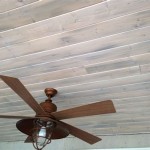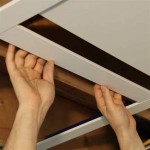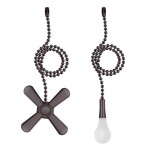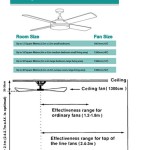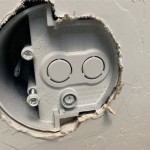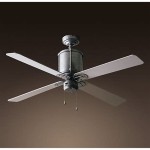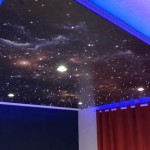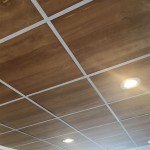What Is a False Ceiling?
A false ceiling, also known as a drop ceiling or suspended ceiling, is a secondary ceiling that is installed below the existing ceiling. It is constructed using various materials such as gypsum boards, metal panels, or even wood. False ceilings serve multiple purposes, from enhancing aesthetics to improving functionality and concealing unsightly elements. They are a popular choice in both residential and commercial settings, and their versatility allows for diverse designs and configurations.
Benefits of False Ceilings
False ceilings offer a range of advantages that make them a desirable choice for interior design and renovation projects. These benefits include:
Aesthetic Enhancement
One of the primary benefits of false ceilings is their ability to enhance the visual appeal of a space. They can be used to create a more modern and sophisticated look, or to complement existing architectural features. With a variety of materials, colors, and finishes available, false ceilings offer ample opportunities for personalization and artistic expression.
Improved Acoustics
By incorporating sound-absorbing materials, false ceilings can effectively reduce noise levels within a room. This is particularly beneficial in areas where sound control is crucial, such as home theaters, offices, and music studios. Acoustic panels or sound-absorbing tiles can be integrated into the false ceiling to minimize unwanted echoes and reverberations.
Concealing Structural Elements
Often, existing ceilings may contain unattractive structural elements such as pipes, wires, or ductwork. False ceilings provide a practical solution for concealing these elements, creating a cleaner and more streamlined aesthetic. Moreover, they can be used to hide unevenness or imperfections in the original ceiling.
Fire Safety
In some cases, false ceilings can contribute to improved fire safety. Materials like gypsum boards provide fire resistance, slowing down the spread of fire and offering valuable time for evacuation. Additionally, they can house sprinkler systems and smoke detectors, ensuring a proactive fire response system.
Enhanced Lighting
False ceilings provide an ideal platform for integrating lighting fixtures. Recessed lighting, spotlights, and track lighting can be seamlessly incorporated, allowing for customized illumination patterns and creating a desired ambiance. The flexibility of false ceilings enables creative and functional lighting arrangements.
Concealing HVAC Systems
Heating, ventilation, and air conditioning (HVAC) systems often require significant space and can be aesthetically unappealing. False ceilings offer a convenient way to conceal these systems, keeping them out of sight while maintaining their functionality. This approach creates a cleaner and more organized appearance.
Cost-Effectiveness
In many instances, installing a false ceiling can prove more cost-effective than replacing or renovating the existing ceiling. The cost of materials and installation typically remains lower than undertaking extensive structural modifications. Moreover, the added benefits of aesthetics and functionality often outweigh the initial investment.
Types of False Ceilings
False ceilings are available in various types, each with specific characteristics and applications. The most common types include:
Gypsum Board Ceilings
Gypsum board ceilings are a popular type of false ceiling, often used in residential and commercial spaces. Gypsum boards are readily available, affordable, and offer a smooth and paintable surface. They provide ample flexibility for creating various shapes and designs. However, they may not be suitable for high-humidity environments.
Metal Panel Ceilings
Metal panel ceilings are known for their durability, moisture resistance, and ease of installation. They are commonly used in areas prone to humidity, such as bathrooms and kitchens. Metal panels come in various materials, including aluminum, steel, and tin, offering diverse styles and finishes.
Tiled Ceilings
Tiled ceilings consist of individual panels or tiles, usually made of mineral fiber, gypsum, or metal. These tiles are easily installed and replaced, offering flexibility for future modifications. Tiled ceilings are often chosen for their sound absorption properties, making them suitable for office environments and media rooms.
Wood Ceilings
Wood ceilings provide a natural and warm aesthetic, adding a touch of elegance to any room. They can be constructed using various wood species, including pine, oak, and cedar, offering diverse textures and grain patterns. Wood ceilings are often used in traditional or rustic settings.
Installation Process
The installation process for false ceilings typically involves the following steps:
1.
Preparation:
The existing ceiling is inspected and cleaned, ensuring proper support for the false ceiling structure.2.
Framing:
A sturdy metal or wooden frame is constructed, outlining the desired shape and dimensions of the false ceiling.3.
Installation of Panels:
The chosen ceiling panels are installed onto the frame, secured using clips or fasteners.4.
Finishing:
Once the panels are in place, any necessary trim or molding is added, and the ceiling is painted or finished according to the desired aesthetic.5.
Lighting and Ventilation:
Lighting fixtures and ventilation systems are installed, ensuring appropriate illumination and air circulation.Considerations for Choosing a False Ceiling
When choosing a false ceiling, several factors should be considered:
1.
Budget:
The cost of materials and installation varies depending on the chosen type and complexity of the design.2.
Aesthetics:
The desired style, color, and overall look should align with the existing interior design.3.
Functionality:
The purpose of the false ceiling, whether acoustic improvement, lighting integration, or concealing structural elements, should be carefully considered.4.
Materials:
The choice of materials should be based on the environment, humidity levels, and fire safety requirements.5.
Installation:
The complexity of the installation process and the availability of skilled professionals should be factored in.By carefully considering these factors, homeowners and designers can choose the most appropriate type of false ceiling for their specific needs and preferences.

False Ceiling Definition Benefits And Various Types Happho

Benefits Of False Ceilings Vm Ceiling Singapore Partition Wall Contractor

What Is False Ceiling Contractorbhai

8 Types Of False Ceilings Commonly Used For Home Ultratech Cement

What About False Ceiling Design

Everything About House False Ceilings Saint Gobain Gyproc

Types Of False Ceiling Vm Singapore Partition Wall Contractor

All About False Ceiling Types Advantages Designs And Costs

How To Maintain The Quality Of False Ceiling West Interiors
8 Types Of False Ceiling For Home
Related Posts

